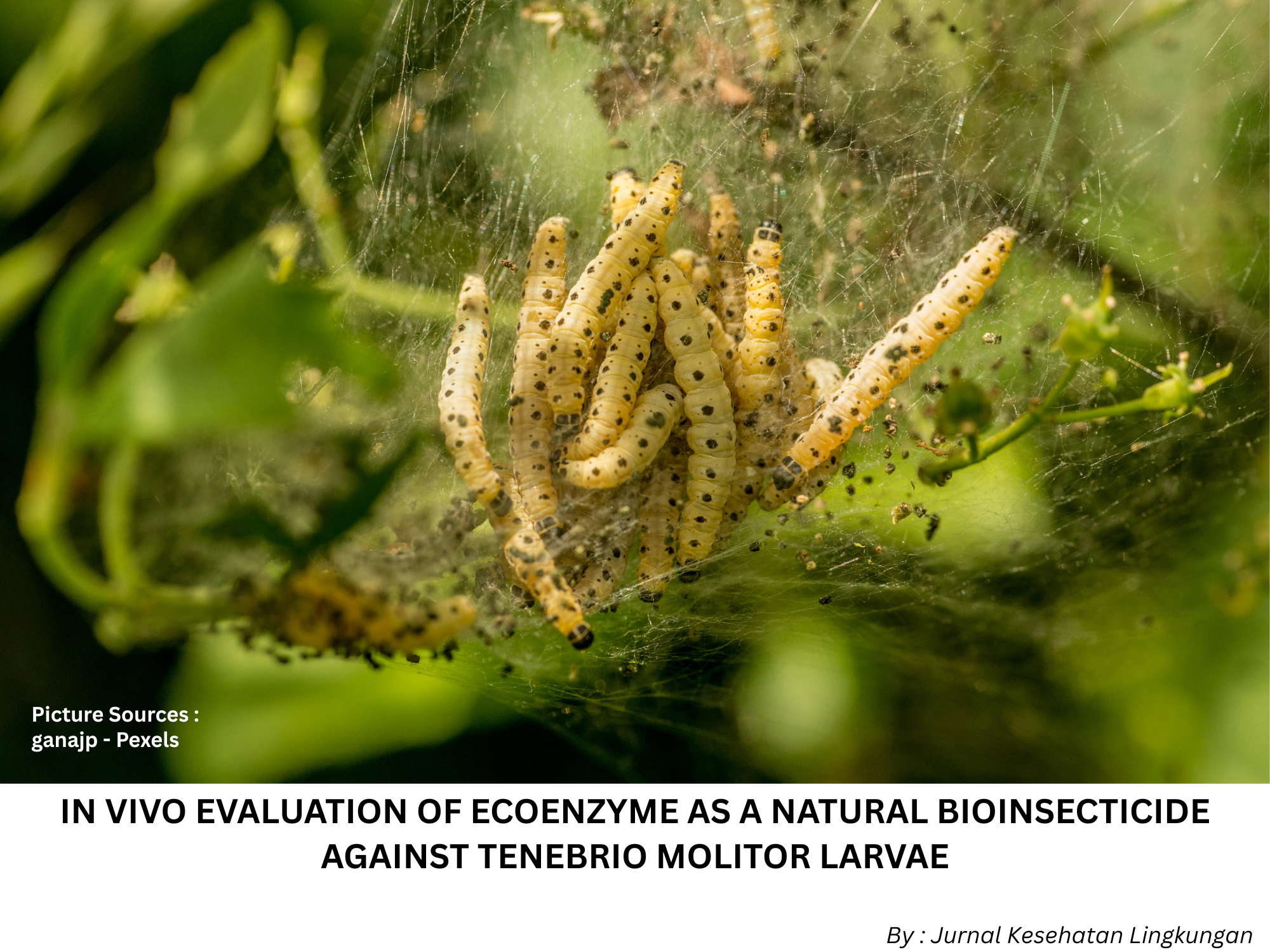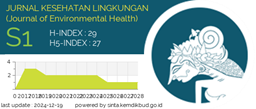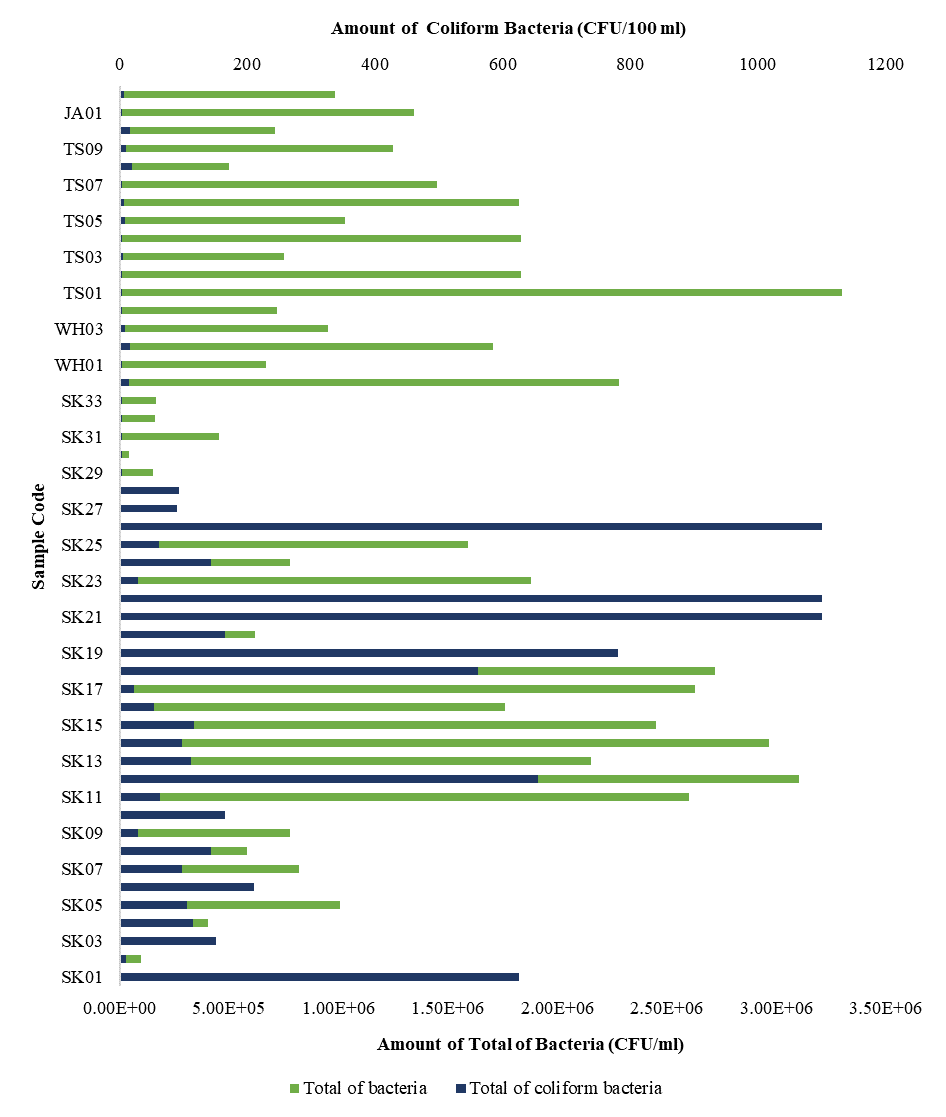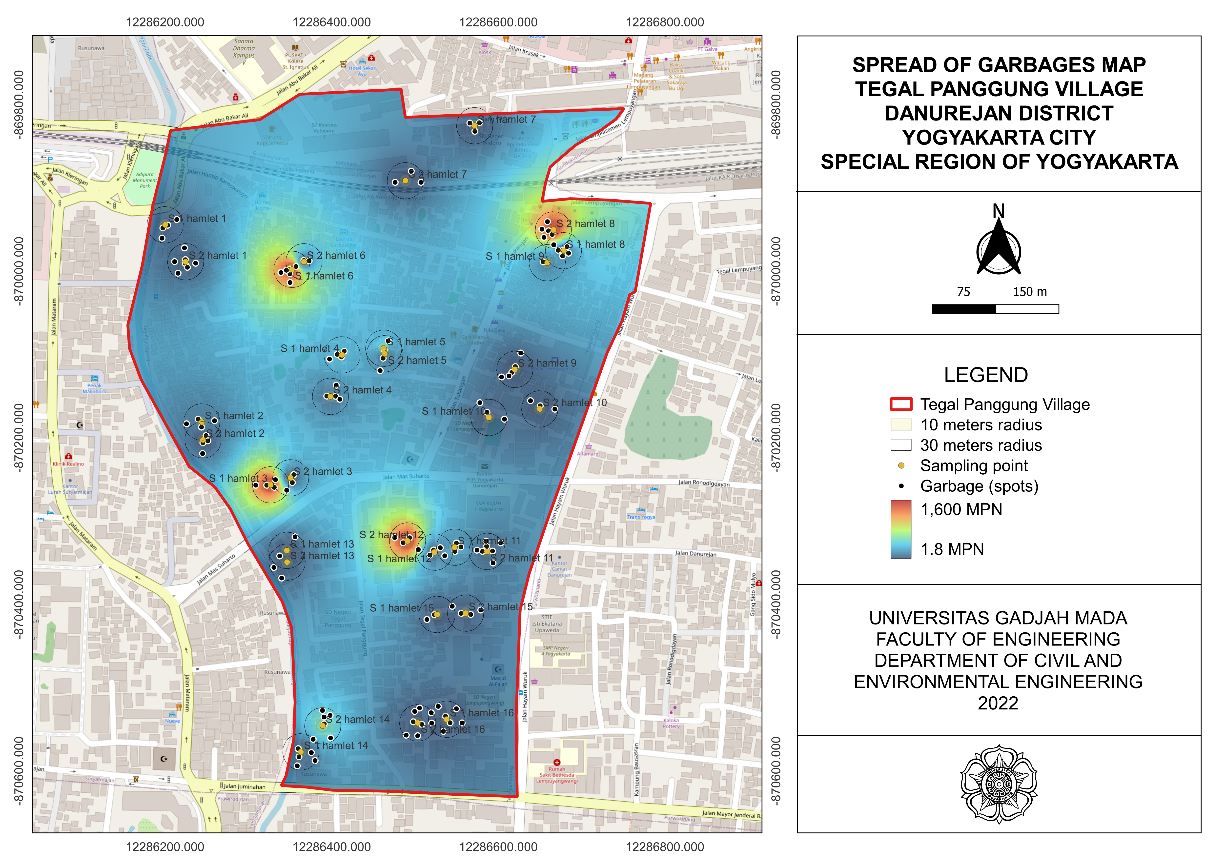In Vivo Evaluation of Ecoenzyme as a Natural Bioinsecticide Against Tenebrio Molitor Larvae

Downloads
Introduction: Organic kitchen waste fermented into eco-enzyme contains organic acids and secondary metabolites with insecticidal potential. We hypothesized that intermediate dilutions would yield higher larval mortality than very low or undiluted solutions by maximizing uptake while limiting rapid deterrence or detoxification responses. Methods: Eco-enzyme was produced from kitchen residues and brown sugar through 90-day fermentation and confirmed to contain acetic acid, lactic acid, flavonoids, and alkaloids (pH 3.0). A randomized design tested five dilutions (0%, 25%, 50%, 75%, 100%) and a chemical insecticide control (Curacron 500 EC). Each treatment had three replicates of 10 Tenebrio molitor larvae (n=180). Solutions were sprayed twice daily for seven days, and mortality recorded before each application. Data were analyzed using Shapiro–Wilk tests and one-way ANOVA (α=0.05). Results and Discussion: Phytochemical screening verified organic acids and bioactive metabolites. By Day 7, cumulative mortality was: control 23.33%, 25% eco-enzyme 46.67%, 50% 13.33%, 75% 30.00%, 100% 33.33%, and chemical insecticide 86.67%. The 25% group showed normal distribution and significantly higher mortality than several other eco-enzyme treatments (p<0.05). This intermediate concentration permitted ingestion and disruption of gut pH, digestive enzymes, and neural pathways, whereas higher concentrations provoked irritation and avoidance, reducing toxin uptake. Conclusion: Eco-enzyme at 25% provides optimal larvicidal activity, highlighting its potential as a biodegradable, low-cost alternative. Its application could support integrated pest management, lowering environmental residues, and promoting sustainable agriculture. Future work should include field validation, non-target assessments, and formulation strategies to enhance stability and scalability.
BPS-Statistics DKI Jakarta Province. Volume of Waste Transported per Day by Type of Waste in DKI Jakarta Province (tons) 2022. DKI Jakarta Province; 2025. https://jakarta.bps.go.id/id/statistics-table/2/OTE2IzI=/volume-sampah-yang-terangkut-per-hari-menurut-jenis-sampah-di-provinsi-dki-jakarta.html
Hariyono H, Madyawati S, Fauziyah S. The Use of Eco-Enzyme as A Larvacide for Aedes Aegypti Mosquito Larvae. International Journal of Scientific Research and Management (IJSRM). 2024;12:1168–1172. https://doi.org/10.18535/ijsrm/v12i08.mp05
Wijekoon P, Koliyabandara PA, Cooray AT. Progress and Prospects in Mitigation of Landfill Leachate Pollution: Risk, Pollution Potential, Treatment and Challenges. Journal of Hazardous Materials. 2022;421(126627):1-18. https://doi.org/10.1016/j.jhazmat.2021.126627
Nguyen TT, Nguyen HT, Vo TT, Tran MT, Vo ST, Nguyen HL. Utilization of Fruit and Vegetable Waste for Eco-Enzyme Production and its Application in Wastewater Treatment. Environmental Technology and Innovation. 2024;34(103263):1-19. https://doi.org/10.1016/j.eti.2023.103263
Zhang A. From Immunity to Collaboration: Microbes, Waste, and Antitoxic Politics. Current Anthropology. 2021;62(24):298–310. https://doi.org/10.1086/715542
Benny N, Shams R, Dash KK, Pandey VK, Bashir O. Recent Trends in Utilization of Citrus Fruits in Production of Eco-Enzyme. Journal of Agriculture and Food Research. 2023;13(100657):1-10. https://doi.org/10.1016/j.jafr.2023.100657
Maryanti A, Hastuti D, Hardi N. Effectiveness Test of Onion Peel Eco Enzyme as Bioinsecticide for Armyworm Pest (Spodoptera litura). Jurnal Agronomi Tanaman Tropika (JUATIKA). 2024;6(2):312-323. https://doi.org/10.36378/juatika.v6i2.3589
Ara ZG, Haque AR. A Comprehensive Review on Synthetic Insecticides: Toxicity to Pollinators, Associated Risk to Food Security, and Management Approaches. Journal of Biosystems Engineering. 2021;46:254–272. https://doi.org/10.1007/s42853-021-00104-y
Mali H, Shah C, Raghunandan BH, Prajapati AS, Patel DH, Trivedi U, et al. Organophosphate Pesticides an Emerging Environmental Contaminant: Pollution, Toxicity, Bioremediation Progress, and Remaining Challenges. Journal of Environmental Sciences. 2023;127:234–250. https://doi.org/10.1016/j.jes.2022.04.023
Pereira V, Figueira O, Castilho PC. Flavonoids as Insecticides in Crop Protection—A Review of Current Research and Future Prospects. Plants. 2024;13(6):1-15. https://doi.org/10.3390/plants13060776
Surya NR, Karima R, Renjana E, Ramadani A, Umarudin U, Istiqomah N, et al. Investigation of Eco-Enzyme from Pineapple (Ananas Comosus (L.) Merr.) Waste: Chemical Composition, Antibacterial Activity, and Molecular Docking Approach. Waste and Biomass Valorization. 2024;15:1–13. https://doi.org/10.1007/s12649-024-02492-6
Ribeiro VR, Delgado OHD, Ulrich AC, Rizzetti TM, Sanchez BA, Souza SRC, et al. The Use of Microalgae-Microbial Fuel Cells in Wastewater Bioremediation and Bioelectricity Generation. Journal of Water Process Engineering. 2022;48(102882):1-8. https://doi.org/10.1016/j.jwpe.2022.102882
Jayaveni M, Johnson TEYS, Gopinathan S, Kannan M, Anandham R, Kannan R, et al. Synergistic Effects of Insecticides and Lactic Acid Bacterial Formulation on Plutella Xylostella (L.) and Beneficial Coccinellids in Cauliflower. Plant Science Today. 2025;12(1):1–10. https://doi.org/10.14719/pst.6099
Plata-Rueda A, Zanuncio JC, Serrão JE, Martínez LC. Origanum Vulgare Essential Oil Against Tenebrio Molitor (Coleoptera: Tenebrionidae): Composition, Insecticidal Activity, and Behavioral Response. Plants. 2021;10(11):1-13. https://doi.org/10.3390/plants10112513
Aş Y, Selvitopi Z, Eroğlu GB. Two Novel Densoviruses from Storage Pest Insects (Zophobas Morio And Tenebrio Molitor) in Türkiye: Genomic and Ultrastructural Comparison. Journal of Stored Products Research. 2025;111(102549):1-8. https://doi.org/10.1016/j.jspr.2025.102549
Prasetyaningtyas DR, Isnaini A, Mahyudin A. Studi Pemanfaatan Eco Enzyme Berbahan Limbah Dapur Terhadap Kualitas Air Limbah Domestik. Presipitasi: Media Komunikasi dan Pengembangan Teknik Lingkungan. 2023;20(3):655–668. https://doi.org/10.14710/presipitasi.v20i3.655-668
Galintin O, Rasit N, Hamzah S. Production and Characterization of Eco Enzyme Produced from Fruit and Vegetable Wastes and its Influence on the Aquaculture Sludge. Biointerface Research in Applied Chemistry. 2021;11(3):10205–10214. https://doi.org/10.33263/BRIAC113.1020510214
Abdullah N, Zubair A, Mangarengi N, Rachman R, Tumpu M, Djamaluddin D. Identification of Eco Enzyme Characteristics from Organic Waste. IOP Conference Series: Earth and Environmental Science. 2023;1268aa(012015):1-6. https://doi.org/10.1088/1755-1315/1268/1/012015
StatPearls Publishing. Independent t-Test. Treasure Island (FL): StatPearls Publishing; 2024. https://www.ncbi.nlm.nih.gov/books/NBK606084/#:~:text=Testing%20the%20difference%20between%20the,test%20or%20one%20of%20its
Souza RR, Toebe M, Mello AC, Bittencourt KC. Sample Size and Shapiro-Wilk Test: An Analysis for Soybean Grain Yield. European Journal of Agronomy. 2023;142(126666):1-9. https://doi.org/10.1016/j.eja.2022.126666
Ayilara MS, Adeleke BS, Akinola SA, Fayose CA, Adeyemi UT, Gbadegesin LA, et al. Biopesticides as a Promising Alternative to Synthetic Pesticides: A Case for Microbial Pesticides, Phytopesticides, and Nanobiopesticides. Frontiers in Microbiology. 2023;14(1040901):1-16. https://doi.org/10.3389/fmicb.2023.1040901
Bumbulyte G, Budiene J, Buda V. Essential Oils and Their Components Control Behaviour of Yellow Mealworm (Tenebrio Molitor) Larvae. Insects. 2023;14(7):1-14. https://doi.org/10.3390/insects14070636
Castellane TRLC, Lemos MVF, Escriche B. Improving Bacillus Thuringiensis Toxins for Better Pest Control. Frontiers in Microbiology. 2021;12(799011):1-2. https://doi.org/10.3389/fmicb.2021.799011
Dinata GF, Siswadi E, Erdiansyah I. Uji Efikasi Beberapa Ekstrak Tanaman Obat Terhadap Larva Tenebrio Molitor L. (Coleoptera: Tenebrionidae) Secara In Vitro. Agroscript: Jurnal Aplikasi Ilmu Pertanian. 2024;6(1):1–10. https://doi.org/10.36423/agroscript.v6i1.1275
Farhan M, Pan J, Hussain H, Zhao J, Yang H, Ahmad I, et al. Aphid-resistant Plant Secondary Metabolites: Types, Insecticidal Mechanisms, and Prospects For Utilization. Plants. 2024;13(16):1-20. https://doi.org/10.3390/plants13162332
Irmawati I, Masriany M, Iqbal A. Pengaruh Pemberian Pestisida Nabati Terhadap Larva Tenebrio Molitor (Ulat Hongkong) pada Tanaman Sawi (Brassica Juncea) di BBPP Batangkaluku Provinsi Sulawesi Selatan. Filogeni: Jurnal Mahasiswa Biologi. 2023;3(1):33–37. https://doi.org/10.24252/filogeni.v3i1.30314
Ismail AY, Nainggolan MF, Nauli AP. Characterizing the Chemical Composition of Eco-Enzymes Derived from Vegetable and Fruit Sources. International Journal of Design & Nature and Ecodynamics. 2024;19(3):1051–1060. https://doi.org/10.18280/ijdne.190334
Karimah M, Lusiani CE. Analysis of Eco-Enzyme Characteristics with Variation of “Tape” Yeast Concentrations. Distilat: Jurnal Teknologi Separasi. 2024;10(1):234–243. https://doi.org/10.33795/distilat.v10i1.4195
Liubana D, Leiwakabessy P, Elly W, Naraswari A, Lainsamputty J, Warella J, et al. Organoleptic Test of Eco Enzyme: Fermentation of Banana Peel Waste. Bioma: Jurnal Ilmiah Biologi. 2023;12:44–53. https://doi.org/10.26877/bioma.v12i1.14803
Maryanti A, Wulandari F. Production and Organoleptic Test of Onion Peel Eco-Enzyme. Jurnal Biologi Tropis. 2023;22(2):311–318. https://doi.org/10.29303/jbt.v23i2.4708
Mesquita E, Hu S, Lima TB, Golo PS, Bidochka MJ. Utilization of Metarhizium as an Insect Biocontrol Agent and A Plant Bioinoculant with Special Reference to Brazil. Frontiers in Fungal Bioogy. 2023;4(1276287):1-10. https://doi.org/10.3389/ffunb.2023.1276287
Rotthong M, Takaoka M, Oshita K, Rachdawong P, Gheewala SH, Prapaspongsa T. Life Cycle Assessment of Integrated Municipal Organic Waste Management Systems in Thailand. Sustainability. 2023;15(1):1-31. https://doi.org/10.3390/su15010090
Abdulhafedh A. Analyzing the Impact of Age and Gender on COVID-19 Deaths Using Two-Way ANOVA. Open Access Library Journal. 2023;10(1):1-10. https://doi.org/10.4236/oalib.1109658
Nurlatifah I, Agustine D, Puspasari EA. Production and Characterization of Eco-Enzyme from Fruit Peel Waste. In: Proceedings of the International Conference on Science and Sustainable Technology (ICSST). 2021; Tangerang, Indonesia. EAI. 2022. https://doi.org/10.4108/eai.25-11-2021.2318816
Pathak VM, Verma VK, Rawat BS, Kaur B, Babu N, Sharma A, et al. Current Status of Pesticide Effects on Environment, Human Health and It’s Eco-Friendly Management as Bioremediation: A Comprehensive Review. Frontiers in Microbiology. 2022;13(962619):1-7. https://doi.org/10.3389/fmicb.2022.962619
Inaba K, Ebihara K, Senda M, Yoshino R, Sakuma C, Koiwai K, et al. Molecular Action of Larvicidal Flavonoids on Ecdysteroidogenic Glutathione S-Transferase Noppera-Bo in Aedes aegypti. BMC Biology. 2022;20(1):1-20. https://doi.org/10.1186/s12915-022-01233-2
Erdogan-Kablan S, Yayla S, Hurkul MM, Cetinkaya A, Nemutlu E, Ozkan S A. Recent Advancements in the Bioactive Alkaloids Analysis in Plant and Biological Specimen: from the Perspective of Activity, Sample Preparation, and Analytical Method Selection. Journal of Chromatography. 2025;1258(124592):1-19. https://doi.org/10.1016/j.jchromb.2025.124592
Reegan AD, Kumar PS, Asharaja AC, Devi C, Jameela S, Balakrishna K, et al. Larvicidal and Ovicidal Activities of Phenyl Acetic Acid Isolated from Streptomyces Collinus Against Culex Quinquefasciatus and Aedes Aegypti (Diptera: Culicidae). Experimental Parasitology. 2021;226(108120):226–227. https://doi.org/10.1016/j.exppara.2021.108120
Punia A, Chauhan NS, Singh D, Kesavan AK, Kaur S, Sohal SK. Effect of Gallic Acid on the Larvae of Spodoptera Litura and its Parasitoid Bracon Hebetor. Scientific Reports. 2021;11(1):1-11. https://doi.org/10.1038/s41598-020-80232-1
Syahputra RA, Dalimunthe A, Utari ZD, Halim P, Sukarno MA, Zainalabidin S, et al. Nanotechnology and Flavonoids: Current Research and Future Perspectives on Cardiovascular Health. Journal of Functional Foods. 2024;120(106355):1-19. https://doi.org/10.1016/j.jff.2024.106355
Al AEH, Al KH, Al Shaibani MB. The Use of Alkaloids as Botanical Insecticides. ACE Research Journal of Microbiology and Biotechnology. 2022;2(2):33–41. https://www.researchgate.net/publication/364380158_The_Use_of_Alkaloids_as_Botanical_Insecticides
Wei W, Wang D, Li H, Tian H, Wang Z, Feng S. Total Alkaloid Extract of Nelumbinis Plumula Promoted Sleep in Pcpa-Induced Insomnia Rats by Affecting Neurotransmitters and Their Receptor Activities. International Journal of Molecular Sciences. 2025;26(8):1-22. https://doi.org/10.3390/ijms26083684
Baz MM, El-Shourbagy NM, Alkhaibari AM, Gattan HS, Alruhaili MH, Selim A. Larvicidal Activity of Acacia Nilotica Extracts Against Culex Pipiens and Their Suggested Mode of Action by Molecular Simulation Docking. Scientific Reports. 2024;14(1):1-18. https://doi.org/10.1038/s41598-024-56690-2
Li S, Lin X, Duan L. Harnessing the Power of Natural Alkaloids: The Emergent Role in Epilepsy Therapy. Frontiers in Pharmacology. 2024;15(1418555):1-17. https://doi.org/10.3389/fphar.2024.1418555

This work is licensed under a Creative Commons Attribution-NonCommercial-ShareAlike 4.0 International License.
1. Copyright of all journal manuscripts is held by the Jurnal Kesehatan Lingkungan.2. Formal legal provisions to access digital articles of electronic journal are subject to the provision of the Creative Commons Attribution-ShareAlike license (CC BY-NC-SA), which means that Jurnal Kesehatan Lingkungan is rightful to keep, transfer media/format, manage in the form of databases, maintain, and publish articles.
3. Published manuscripts both printed and electronic are open access for educational, research, and library purposes. Additionally, the editorial board is not responsible for any violations of copyright law.
JKESLING by UNAIR is licensed under a Creative Commons Attribution-ShareAlike 4.0 International License.







































